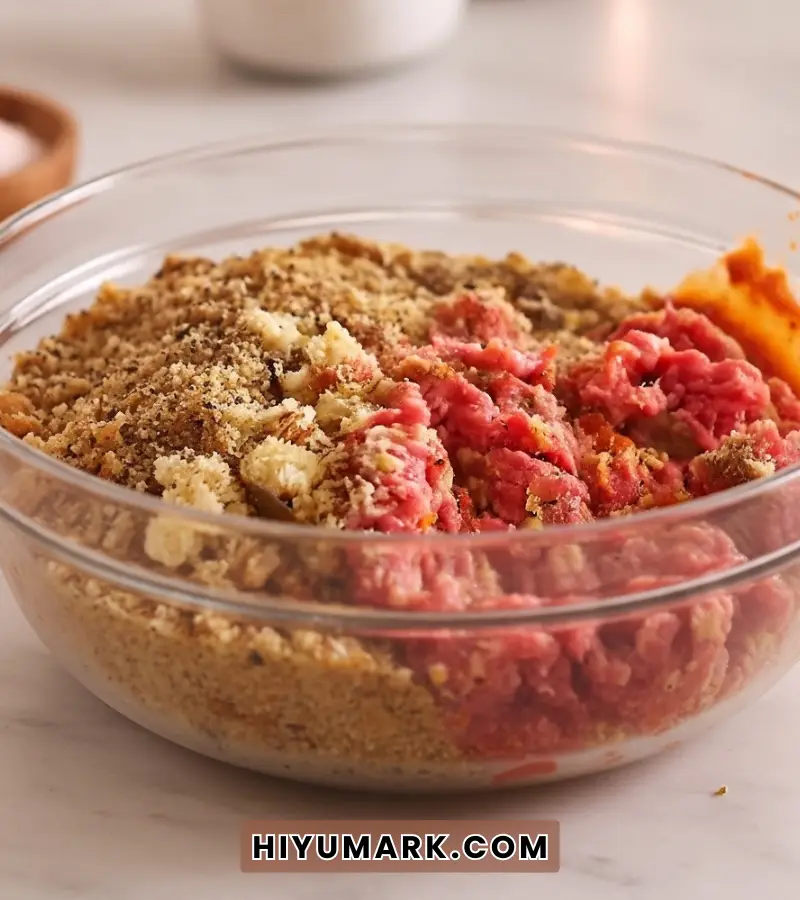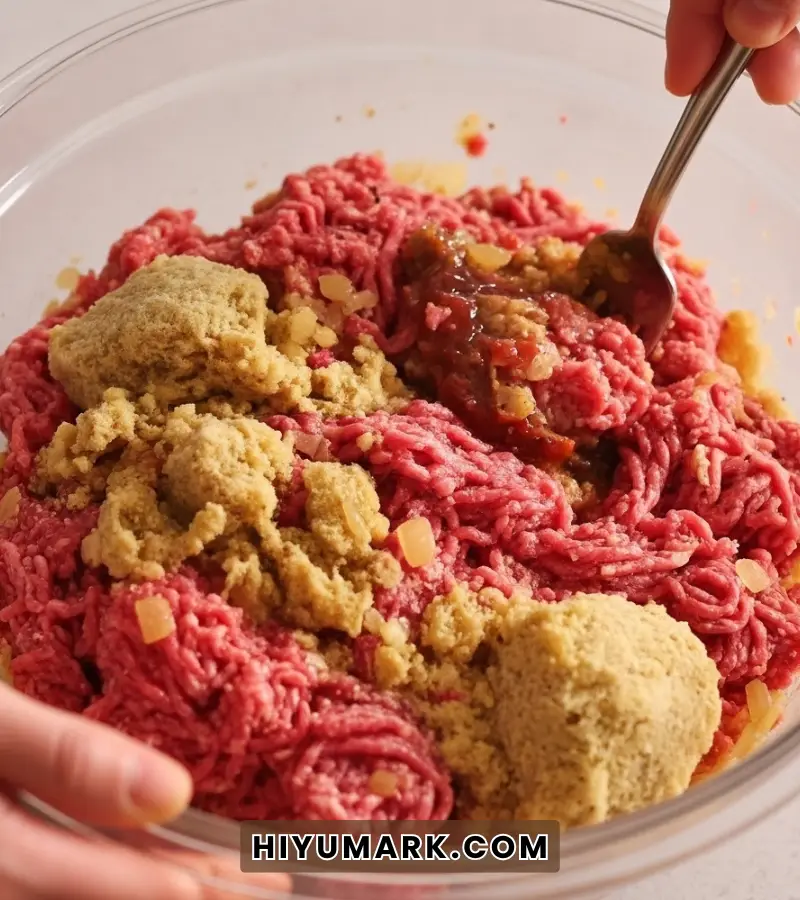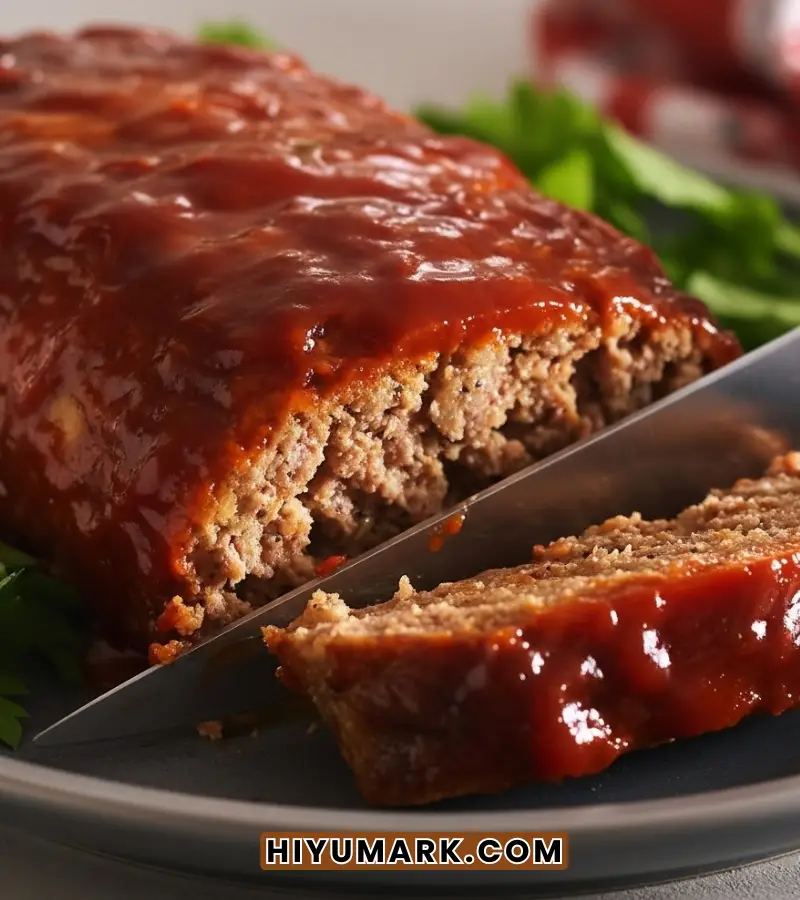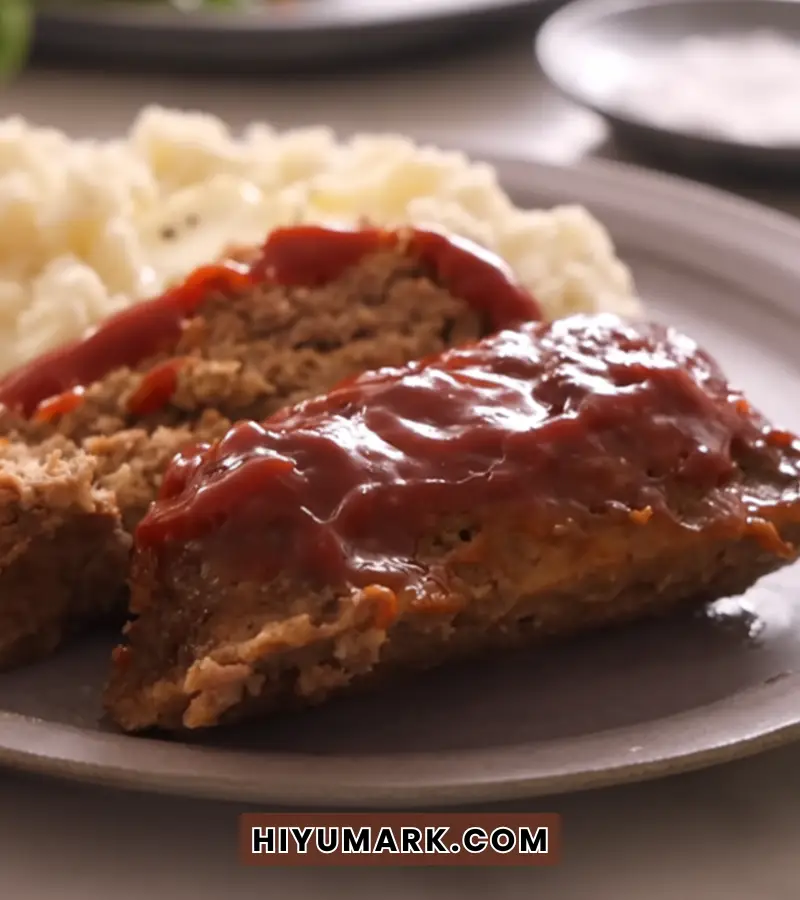I grew up on this humble loaf, and I still make it today.
In this guide, I share a complete Depression-Era meatloaf Recipe you can trust. You will learn the history, the method, budget swaps, and pro tips. I will keep it simple, smart, and true to the era.
What Is a Depression-Era Meatloaf? History and Spirit
This loaf was born from need. Families had little money and many mouths to feed. Cooks learned to stretch meat with bread, oats, and veggies. They made food that filled bodies and lifted hearts.
The Depression-Era meatloaf Recipe shows that skill beats cost. It uses smart binders, gentle heat, and common spices. It turns scraps into comfort. It still fits busy, budget homes today.
If this skillet supper hits the spot, try my Hoover Stew – same cozy flavor with pasta, tomato, and simple pantry staples.
Prefer a lighter side? Ladle some WPA Soup – packed with celery, onion, and leftover vegetables simmered into pure warmth.
Craving something heartier? My Poor Man’s Meal brings smoky skillet comfort, potatoes, onions, and beef – all on a tight budget.
For breakfast the next day, serve Creamed Chipped Beef on Toast – rich, salty, and perfect with leftover meatloaf slices.
Core Ingredients and Budget Swaps
These are the classics. Use what you have. Keep the spirit of the dish.

Base
- 1 pound ground beef, 80 to 85 percent lean
- 1 small onion, finely chopped
- 1 egg
- 1 cup soft bread crumbs or quick oats
- 1 cup milk or water
- 2 tablespoons ketchup or tomato paste
- 1 teaspoon salt
- 1 teaspoon mustard
- 1 teaspoon Worcestershire sauce
- 1 teaspoon black pepper
Budget Swaps
- Use half beef and half ground turkey or pork to cut cost.
- Swap milk with water, broth, or canned evaporated milk.
- Use stale bread, crushed crackers, or oats for the binder.
- Add grated carrot, celery, or zucchini for bulk and moisture.
Flavor Boosts
- A pinch of paprika adds warmth.
- A splash of vinegar brightens the glaze.
- Garlic powder rounds the taste without cost.
I have made this Depression-Era meatloaf Recipe with all the swaps above. It still tastes rich and cozy.
Step-by-Step: Classic Depression-Era Meatloaf Recipe
This is the full roadmap – simple ingredients, no fancy tools, and the exact method that makes this loaf tender, sliceable, and packed with vintage comfort.
Follow each step and you’ll get the same dependable result every time.
Yield
- 8 to 10 slices
Time
- 15 minutes prep
- 55 to 65 minutes bake
Temperature
- Bake at 350°F
- Finish at 160°F internal temp
Steps
- Make a panade. Stir the crumbs or oats with milk. Let it sit 5 minutes.
- Mix the meat. Add beef, onion, egg, ketchup, mustard, salt, pepper, and Worcestershire. Fold in the panade. Do not overmix.
- Shape. Form a loaf on a lined sheet pan. Or use a loaf pan for tidy sides.
- Glaze. Spread 2 tablespoons ketchup on top. Add a small splash of vinegar if you like.
- Bake. Cook 50 to 60 minutes. Check for 160°F in the center.
- Rest. Let it stand 10 minutes. Slice with a sharp knife.
Notes from My Kitchen
- Wet hands stop the meat from sticking while shaping.
- A sheet pan gives more browning and less pooling fat.
- If you double the batch, split it into two small loaves.
This is the core Depression-Era meatloaf Recipe I teach new cooks. It is easy, fast, and low stress.
Proven Variations That Stay True to the Era
Even when ingredients were scarce, home cooks found clever ways to stretch flavors without losing the soul of the dish.
These variations honor that spirit – simple swaps, pantry-friendly additions, and seasonings that keep the recipe humble yet satisfying.
Oat and Veggie Loaf
- Use 1 cup oats.
- Add 1 grated carrot and 1 chopped celery stalk.
- Bake as directed.
Tomato Soup Glaze
- Mix 1 cup condensed tomato soup with 1 tablespoon brown sugar.
- Spoon on during the last 20 minutes of baking.
Onion Soup Mix Version
- Stir in 2 tablespoons dry onion soup mix.
- Skip extra salt.
Meat Mix Option
- Use 1 part beef, 1 part pork, 1 part turkey.
- Keep total weight at 1 pound for easy timing.
Spice Trail
- Add thyme, rosemary, or smoked paprika.
- Keep it light so the loaf stays classic.
I have tried each twist with the base Depression-Era meatloaf Recipe. Each keeps the thrift and comfort, yet brings new notes.
Cost Breakdown and Money-Saving Tips
This is an estimate. Prices change by store and region.
Approximate Costs
- Ground beef: medium pack deals are cheapest
- Bread or oats: pennies per serving
- Onion, egg, ketchup, spices: low cost staples
Money-Saving Tips
- Buy family packs of meat and freeze in 1 pound bags.
- Save stale bread in the freezer for crumbs.
- Grate extra veggies from the week to bulk the loaf.
- Watch for store brands. Quality is fine and cost is lower.
- Bake two loaves. Eat one now. Freeze one for later.
A Depression-Era meatloaf Recipe is budget power. It is also low waste.
Nutrition, Food Safety, and Allergen Notes
Nutrition per slice varies with swaps and portion size. A typical slice has moderate protein and fat. Oats or bread add carbs and fiber.

Food Safety
- Cook to 160°F in the center. Use a digital thermometer.
- Rest 10 minutes. Juices settle. Slices stay neat.
- Chill leftovers within 2 hours. Store in the fridge for 3 to 4 days.
Allergens and Swaps
- Gluten: use certified gluten free oats or crumbs.
- Egg: replace with 2 tablespoons ground flax plus 3 tablespoons water.
- Dairy: use water or broth instead of milk.
These steps follow common safe food rules. They keep your Depression-Era meatloaf Recipe safe and tasty.
Make-Ahead, Storage, and Freezer Directions
If you love stress-free dinners or plan meals ahead, this recipe has your back.
Meatloaf handles chilling, reheating, and freezing better than most comfort foods – as long as you store it the right way.
Here’s how to prep it early, save leftovers, and freeze for later without losing flavor or texture.
Make-Ahead
- Mix the loaf up to 24 hours ahead.
- Cover and chill raw. Bake cold loaf 5 to 10 minutes longer.
Fridge Storage
- Wrap slices in foil or place in an airtight box.
- Reheat at 300°F for 12 to 15 minutes. Or use a skillet over low heat.
Freezer Friendly
- Freeze raw loaf, well wrapped, up to 3 months.
- Thaw in the fridge for 24 hours, then bake.
- Or freeze baked slices. Reheat from frozen at 325°F for 20 to 25 minutes.
Batch cooking with this Depression-Era meatloaf Recipe saves time and stress.
Serving Ideas and Leftover Magic
A good meatloaf doesn’t end at dinner – it starts there. The right sides make it comforting, and the leftovers turn into effortless meals the next day.

Here’s how to serve it like a classic and stretch it into something even better.
Classic Sides
- Mashed potatoes or buttered noodles
- Green beans, peas, or a simple salad
- Warm rolls or toast
Leftover Wins
- Sandwich with ketchup and pickles on soft bread
- Hash with diced potatoes and onions in a skillet
- Crumble into tomato sauce for a quick pasta dinner
- Top a baked potato with warm slices and gravy
I often plan for extra. The next-day uses make this Depression-Era meatloaf Recipe a house favorite.
Troubleshooting and Pro Tips From My Kitchen
Even the best home cooks face kitchen mishaps – a dry loaf, a greasy pan, or flavors that fall flat. These aren’t failures; they’re signals our recipe gives us. Over the years, I’ve noted simple tweaks that turn mistakes into mastery.
Dry loaf
- Add more panade next time. Use 1.25 cups liquid for very dry crumbs.
- Do not overbake. Pull at 160°F and rest.
Loaf falls apart
- Mix a bit more. The binder must coat all the meat.
- Let it rest before slicing. This is key.
Greasy pan
- Use a sheet pan. Fat flows away from the loaf.
- Use 85 percent lean beef for balance.
Flat flavors
- Add salt in small steps and taste the panade. It should taste well seasoned.
- A dash of vinegar in the glaze lifts the whole loaf.
Time crunch
- Shape two small loaves. They bake faster.
- Pre-mix the Depression-Era meatloaf Recipe in the morning. Bake at night.
These tips come from years of weeknight cooking and many test bakes.
Frequently Asked Questions
Why did people add oats or bread to meatloaf?
They stretched scarce meat and added moisture. The binder made the loaf tender and held it together.
Can I make a Depression-Era meatloaf Recipe without eggs?
Yes. Use ground flax and water or a commercial egg replacer. The texture stays moist and stable.
What is the best pan for this loaf?
A sheet pan gives better browning and less pooled fat. A loaf pan makes tidy slices but can trap grease.
How do I keep it from drying out?
Use a panade and do not overmix. Bake to 160°F and rest before slicing.
Can I use turkey instead of beef?
Yes. Mix turkey with oats and a bit more oil or milk. Check for 165°F for ground turkey.
How do I make it gluten free?
Use gluten free oats or crumbs and check sauces. The method stays the same.
What can I use instead of ketchup?
Try tomato paste with a bit of water and sugar. Tomato soup also makes a smooth glaze.
Conclusion
This simple loaf shows what care in the kitchen can do. With smart binders and gentle heat, you turn a small amount of meat into a warm, full meal. A Depression-Era meatloaf Recipe proves that comfort does not need a big budget.
Make one loaf this week and note your swaps. Share your tweaks and your story. Subscribe for more thrifty, joyful recipes, and leave a comment with your favorite twist.
Depression-Era Meatloaf Recipe
Course: Main CourseCuisine: AmericanDifficulty: Easy8
servings20
minutes1
hour300
kcal1
hour20
minutesA classic Depression-Era meatloaf made by stretching beef with oats or bread, simple spices, and pantry staples. Tender, budget-friendly, and full of old-fashioned comfort.
Ingredients
1 lb ground beef (80–85% lean)
1 small onion, finely chopped
1 egg
1 cup soft bread crumbs or quick oats
1 cup milk or water
2 tbsp ketchup or tomato paste
1 tsp mustard
1 tsp Worcestershire sauce
1 tsp salt
1 tsp black pepper
Optional: pinch of paprika, 1 tsp vinegar for glaze
Directions
- Preheat oven to 350°F.
- Mix bread crumbs or oats with milk; let rest 5 minutes.
- Add beef, onion, egg, ketchup, mustard, salt, pepper, and Worcestershire; fold gently.
- Shape into a loaf on a sheet pan or in a loaf pan.
- Spread ketchup or tomato paste on top; add vinegar if desired.
- Bake 50–60 minutes or until internal temperature reaches 160°F.
- Rest 10 minutes before slicing.
Recipe Video
Notes
- Wet your hands to shape the loaf cleanly and avoid sticking. Baking on a sheet pan helps drain excess fat and adds more browning on the sides.

